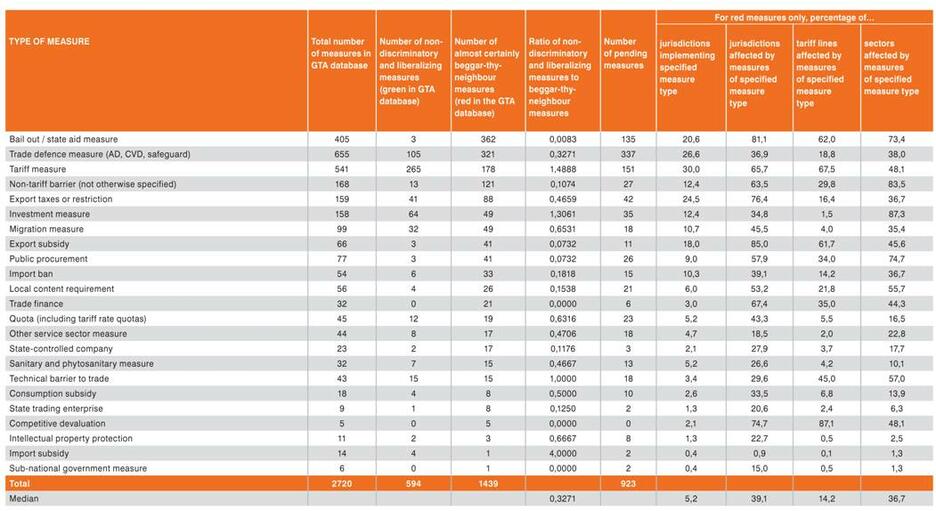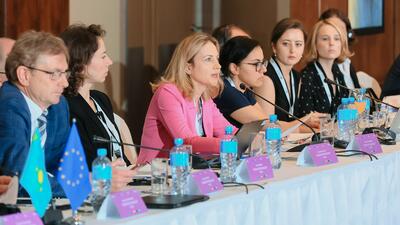Statistics of distortion: Trade policy intervention during the crisis
While tariff changes account for only a fifth of all interventions and while the use of trade defence measures has risen over time, many other forms of non-tariff measures (NTMs) have been deployed. Trade negotiators, exporters and analysts have been interested in NTMs for decades. During much of the post-war era the concern was that as the swamp of tariff measures was drained, the effects of NTMs, some of which impede or discourage international commerce, would become apparent. Since the 1970s, certain analysts have argued that governments might be tempted to substitute NTMs for tariff measures, a temptation made stronger as successive trade accords lowered tariffs. During the global financial crisis and its associated growth slowdown, defenders of open borders have been concerned that governments might resort to NTMs to delay or prevent job losses at, or closure of, domestic firms and shift the burden of adjustment on to foreign companies and rivals.
As deliberations at the World Trade Organization (WTO) and United Nations Conference on Trade and Development have long recognized, it is worth bearing in mind that NTMs can take many different forms. Indicative lists are useful, but governments can create new types of NTMs or blend different measures. As a result, it is better to examine whether a policy measure alters the relative treatment of domestic and foreign rivals, rather than to confine analysis to measures on an indicative list or measures covered by WTO agreements. This is the approach taken by the Global Trade Alert (GTA) team, a group of independent trade analysts around the world that I coordinate. The data reported here summarizes their reports on nearly 2,500 state announcements made since November 2008.
The table reports on the frequency that different types of NTMs have been resorted to since the G20 summit in November 2008. To provide a useful point of comparison, data on tariff measures is also included. The measures are listed in descending order of the total number of times governments have employed each measure in a way that would almost certainly discriminate against a foreign commercial interest. As can be seen, the use of bailouts and state aid measures that tilt the level playing field, as well as trade defence measures, has been more frequent than the use of tariff measures. Even if all financial sector bailouts are excluded, the use of state aid for manufacturing, agriculture and other service sectors occurred more frequently than tariff changes. Overall, more than 80% of the state measures reported in the Global Trade Alert database are NTMs.
Click on the image to see the full size
However, governments did not only harm foreign commercial interests during the recent global financial crisis; nearly 600 measures were taken that either improved the transparency of trade policy regimes, liberalized those regimes, or did not affect the relative treatment of domestic versus foreign commercial interests. Still, for every such measure there were almost 2.5 measures that harmed foreign commercial interests. Among the five measures most used during the crisis, there is considerable variation in the use of measures that harm foreign commercial interests. For example, for every tariff hike there were approximately 1.5 measures that lowered tariffs or improved transparency in the national tariff regime. The reverse is true of the most used NTMs; here beggar-thy-neighbour measures outnumbered trade-promoting measures by more than two to one. In the case of discriminatory bailouts and state aid, the number of beggar-thy-neighbour measures outnumbered commercially neutral measures by more than one hundred to one.
When the history of the first four years of the global economic crisis is written, do not be surprised if bailouts, many of which did not grab headlines like those in the financial sector, get prime billing. Protectionism in the 1930s may have been associated principally with tariff increases and in the 1980s with voluntary export restraints, but now beggar-thy-neighbour measures have taken a different form. The important lesson is that governments must innovate in their policy responses to crises - looking for yesterday's most popular form of intervention may miss where the action is today.
The number of trading partners, tariff lines and sectors affected varies considerably across NTMs, as shown in the table. Trade defence measures may be numerous, and given the number of anti-dumping and countervailing duty investigations in the pipeline, they will soon overtake subsidies in a frequency count. However, trade defence measures affect far fewer jurisdictions, tariff lines and economic sectors than bailouts. This is because anti-dumping and countervailing duty measures target specific products from specific trading partners and are, therefore, more surgical in effect. This is not to downplay the impact of such duties, but rather to argue that the scale of commerce affected by subsidies is likely to be greater.
Export subsidies and competitive devaluations affect large numbers of products too. Measures relating to trade finance and export taxes and restrictions affect a large percentage of trading nations, but not necessarily a large percentage of product categories. Such findings provide a preliminary assessment of the relative importance of different types of NTMs; more definitive assessments will require empirical analyses of the major interventions taken during the crisis. Given that more than 2,000 NTMs have been implemented since November 2008, waiting for the effect of each to be studied in detail may be akin to making the perfect the enemy of the good. Naturally, there is interest in which jurisdictions have been implementing NTMs. Generally, as documented in previous Global Trade Alert reports, the percentage of worldwide totals of protectionist measures implemented by G20 countries has risen every year since 2009. Since November 2008, G20 countries have implemented 47% of the world's harmful NTMs. For comparative purposes it is worth noting that the G20 is responsible for 42% of the world's tariff hikes. More generally, governments that have resorted to protectionism the most have done so by circumventing WTO rules, typically imposing NTMs that are not, or are less stringently, covered by WTO rules rather than relatively transparent trade policy measures such as tariffs.
Although the use of beggar-thy-neighbour policies during the global economic crisis has not reached the scale seen during the 1930s, the substantial implementation of NTMs is disturbing. While governments have not sought to blatantly violate WTO rules, the incompleteness of such rules has been laid bare. Looking forward, perhaps fiscal pressure will induce governments to phase out subsidies and bailouts; but even if these are withdrawn, precious little prevents governments from employing other measures that can distort international commerce.









